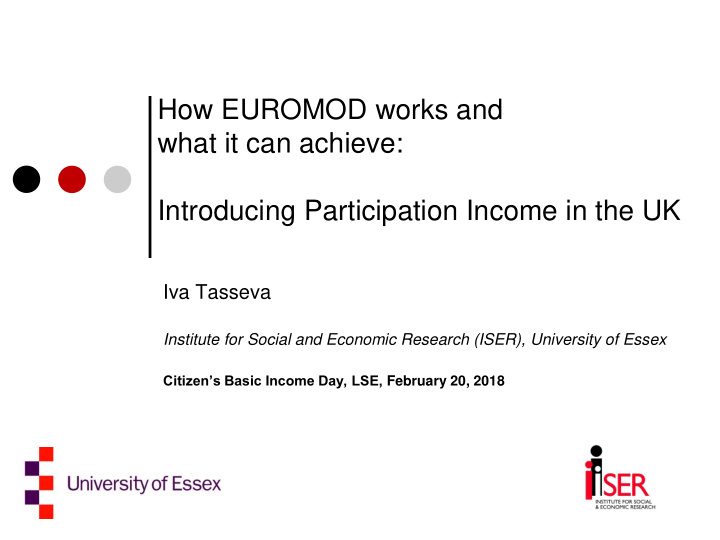



How EUROMOD works and what it can achieve: Introducing Participation Income in the UK Iva Tasseva Institute for Social and Economic Research (ISER), University of Essex Citizen’s Basic Income Day, LSE, February 20, 2018
Outline What is EUROMOD? What can EUROMOD achieve: Designing a Participation Income for the UK Analysing its distributional effects (Atkinson, Leventi, Nolan, Sutherland & Tasseva, 2017)
What is EUROMOD? (1/4) The tax-benefit microsimulation model for the EU-28 It simulates: • cash benefit entitlements for unemployment, family/children, social assistance • direct taxes and national insurance contributions Period of simulated policies: from 2005/07 to 2017 Household survey data for 2008, 2010, 2012, 2015 (some variation across countries) Used to assess the distributional effects of actual and hypothetical policy changes in a meaningful and consistent cross-country way
What is EUROMOD? (2/4) Country- & year-specific tax-benefit rules are applied on household micro-data – from the Family Resources Survey for the UK. EUROMOD calculates: who in the data is entitled to a benefit / liable to pay taxes/NI 1. how much is the benefit entitlement and tax/NI liability 2. households’ net income = reported earned income + 3. simulated benefits – simulated taxes/NI Flexible – the user can implement any policy reform The only restriction is the availability of information in the household survey data Interactions between tax and benefit policies taken into account
What is EUROMOD? (3/4) Includes tools to facilitate the understanding of how reforms affect household incomes and work incentives: Hypothetical Household Tool (HHOT): • Generates hypothetical households based on user-defined characteristics • Abstracts from complexities of real data - focus on specific household types Policy Effects Tool (PET): • Calculates % change in mean household net income due to policy reforms • Income changes decomposed by tax-benefit policy and decile groups Marginal Effective Tax Rates (METR) tool: • Calculates work incentives at the intensive margin • Measures how attractive it is to work longer hours Net Replacement Rates (NRR) tool (in progress) : • Calculates work incentives at the extensive margin • Measures how attractive it is to work vs not to work
What is EUROMOD? (4/4) Publicly available Visit our website www.euromod.ac.uk Email euromod@essex.ac.uk for access to the model and data Regular free training courses EUROMOD Working Paper series
What can EUROMOD achieve? (1/3) T. Atkinson, C. Leventi, B. Nolan, H. Sutherland & I. Tasseva (2017) Reducing poverty and inequality through tax-benefit reform and the minimum wage: the UK as a case-study , Journal of Economic Inequality Motivation: Reduce inequality and poverty through redistribution Address a structural problem in the transfer system, using the UK as a case study • i.e. increased reliance on means-testing poverty trap as well as unmet needs and diminished social justice due to non-take-up Refine and assess the proposals outlined in Atkinson (2015) Implemented with EUROMOD and the Family Resources Survey Experimented with specific options and variations (aided by HHOT)
What can EUROMOD achieve? (2/3) Simulation of Participation Income (PI) : A form of partial Basic Income – integrated into the existing system; only partly replacing it Assumed all adults meet participation condition Included in existing means-tests: Reduce reliance on means-testing – lift some families out of it entirely Full PI receipt for those not taking up their means-tested entitlements Other changes to existing policies: More progressive income tax structure • more bands and higher top rates • earned income tax discount for low earners Increase in NI contributions for high earners Large increase to universal Child Benefit Revenue-neutral (first round) – PI level set at £75 per week (43% of poverty line)
What can EUROMOD achieve? (3/3) Main results (i.e. first-order distributional effects): Substantial reduction in inequality: drop in Gini by 5.7ppts or 18% Substantial reduction in the poverty headcount (5.8ppts or 38%) and poverty gap (2.6ppts or 58%) Majority of gainers at the bottom and middle of the income distribution Losers concentrated in the richest three decile groups Drop in means-tested benefits expenditure Incentives to work vs not to work improve
Thank you! itasseva@essex.ac.uk www.euromod.ac.uk
Recommend
More recommend